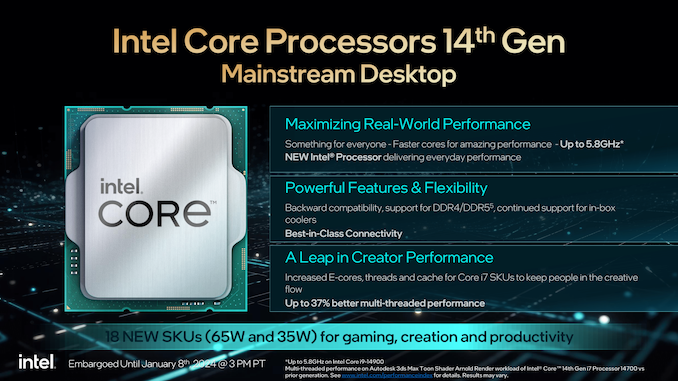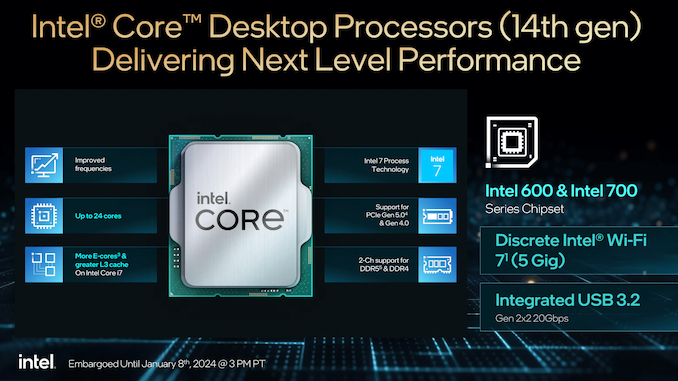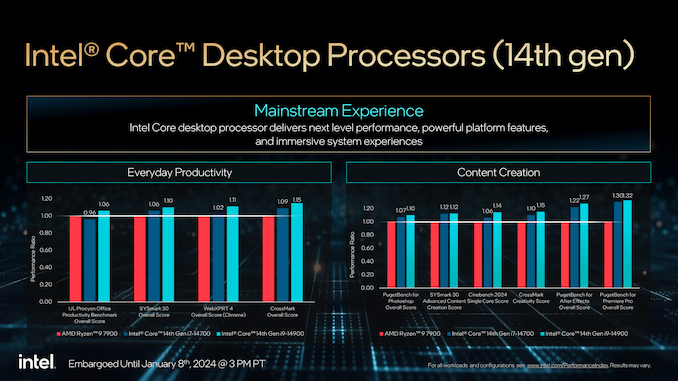Intel Announces non-K 14th Gen Core Desktop Processors: Raptor Lake in 65 W to 35 W Flavors
by Gavin Bonshor on January 8, 2024 6:02 PM EST
We typically see the flagship K-series chips first whenever Intel launches a new family of desktop processors. These show the maximum potential for improvement in generational performance, such as IPC and core clock speeds, and show off the latest family to the best possible effect. Usually, a few months later, Intel launches their non-K-series SKUs, which have lower TDPs, with minor drops in core clock speeds, but offer the same level of core configurations for a usually lower price.
During CES 2024, Intel has launched the rest of their 14th Generation Core series processors, including models such as the Core i9-14900, as well as non-K F SKUs and the lower power T models. For the first time in this generation, we're also getting a trifecta of Raptor Lake refresh Core i3 processors and two entry-level models, the Intel Processor 300 and the Processor 300T.
Adding multiple models to the 14th Gen Core series for desktop families means there's plenty of choice for users regardless of their requirements, with the majority of the new SKUs coming with either a 65 W or 35 W base TDP. Finally, we have the full Raptor Lake refresh for desktop offering, and users looking for a lower cost, but typically solid performance will find plenty to sink their teeth into with lots of chips to select from.
Below is our more recent Intel Raptor Lake processor coverage, including 14th and 13th Gen:
- Intel Core i9-14900K, Core i7-14700K, and Core i5-14600K Review: Raptor Lake Refreshed
- Intel Announces 14th Gen Core Series For Desktop: Core i9-14900K, Core i7-14700K, and Core i5-14600K
- Intel Core i9-13900K and i5-13600K Review: Raptor Lake Brings More Bite
- The Intel Core i3-13100F Review: Finding Value in Intel's Cheapest Core Chip
Intel 14th Gen Core Non-K Series: 17 New CPUs, 65 W & 35 W Models Available
Despite Intel's K-series SKUs garnering the most attention regarding a desktop CPU launch, you would think that these are Intel's biggest sellers. In reality, it's the non-K processors where Intel sells most of its volume, with many OEMs and vendors usually electing to use these lower-powered chips for many different systems. Many users don't even overclock, and with Intel and AMD offering a good variation of different automatic overclocking tuning through turbo frequencies, there's less need to squeeze out that performance as the chip maker has done much of the grunt work already.
Intel has 17 new processors for their 14th Gen Core series Raptor Lake refresh, with all of the regular (without nomenclature) Core i7 and Core i5 offerings with a base TDP of 65 W. In terms of turbo TDP, this varies depending on the core and thread count, with the flagship model announced today, the Core i9-14900, coming with a 125 W base TDP and a turbo TDP of 219 W. It's important to learn the distinctions between the different nomenclature, with the K/KF meaning the chip can be overclocked, whereas those with no nomenclature are ratio locked.
The T series, which means low power, typically operates with the lowest power and has a base TDP of just 35 W. The F series chips, whether that be with the K series or not, denote that the processor doesn't come with integrated graphics, and means it must be paired up with a discrete graphics card
| Intel 14th Gen Core, Raptor Lake-R Line-Up Full Stack as of 08/01/24) |
||||||||||
| AnandTech | Cores P+E/T |
P-Core Base |
P-Core Turbo |
E-Core Base |
E-Core Turbo |
L3 Cache (MB) |
iGPU | Base W |
Turbo W |
Price ($) |
| i9-14900K | 8+16/32 | 3200 | 6000 | 2400 | 4400 | 36 | 770 | 125 | 253 | $589 |
| i9-14900KF | 8+16/32 | 3200 | 6000 | 2400 | 4400 | 36 | - | 125 | 253 | $564 |
| i9-14900 | 8+16/32 | 2000 | 5600 | 1500 | 4300 | 36 | 770 | 65 | 219 | $549 |
| i9-14900F | 8+16/32 | 2000 | 5800 | 1500 | 4300 | 36 | - | 65 | 219 | $524 |
| i9-14900T | 8+16/32 | 1100 | 5500 | 800 | 4000 | 36 | 770 | 35 | 106 | $549 |
| i7-14700K | 8+12/28 | 3400 | 5600 | 2500 | 4300 | 33 | 770 | 125 | 253 | $409 |
| i7-14700KF | 8+12/28 | 3400 | 5600 | 2500 | 4300 | 33 | - | 125 | 253 | $384 |
| i7-14700 | 8+12/28 | 2100 | 5400 | 1500 | 4200 | 33 | 770 | 65 | 219 | $384 |
| i7-14700F | 8+12/28 | 2100 | 5400 | 1500 | 4200 | 33 | - | 65 | 219 | $359 |
| i5-14600K | 6+8/20 | 3500 | 5300 | 2600 | 4000 | 24 | 770 | 125 | 181 | $319 |
| i5-14600KF | 6+8/20 | 3500 | 5300 | 2600 | 4000 | 24 | - | 125 | 181 | $294 |
| i5-14600 | 6+8/20 | 2700 | 5200 | 2000 | 3900 | 24 | 770 | 65 | 154 | $255 |
| i5-14500 | 6+8/20 | 2600 | 5000 | 1900 | 3700 | 24 | 770 | 65 | 154 | $232 |
| i5-14400 | 6+4/16 | 2500 | 4700 | 1800 | 3500 | 20 | 730 | 65 | 148 | $221 |
| i5-14400F | 6+4/16 | 2500 | 4700 | 1800 | 3500 | 20 | - | 65 | 148 | $196 |
| i5-14600T | 6+8/20 | 1800 | 5100 | 1200 | 3600 | 24 | 770 | 35 | 92 | $255 |
| i5-14500T | 6+8/20 | 1700 | 4800 | 1200 | 3400 | 24 | 770 | 35 | 92 | $232 |
| i5-14400T | 6+4/16 | 1500 | 4500 | 1100 | 3200 | 20 | 730 | 35 | 82 | $221 |
| i3-14100 | 4+0/8 | 3500 | 4700 | - | - | 12 | 770 | 60 | 110 | $134 |
| i3-14100F | 4+0/8 | 3500 | 4700 | - | - | 12 | - | 58 | 110 | $109 |
| i3-14100T | 4+0/8 | 2700 | 4400 | - | - | 12 | 730 | 35 | 69 | $134 |
| Processor 300 | 2+0/4 | 3900 | - | - | - | 6 | 710 | 46 | - | $82 |
| Processor 300T | 2+0/4 | 3400 | - | - | - | 6 | 710 | 35 | - | $82 |
Note: New chips are bolded; preexisting SKUs are not.
It's worth pointing out that for all of Intel's 14th Gen Core series processors, users can pair these up with either DDR5 or DDR4 memory, which gives the advantage of platform choice. Users can't simultaneously use DDR5 or DDR4 on the same board, so electing which pathway to go down becomes a personal decision. Typically, DDR5 memory is pricier, but things have evened out price-wise in recent months, with DDR4 memory still offering the best bang for buck performance. Each processor has a different level of DDR5 support throughout the stack, such as DDR5-5600 or DDR5-4800, typically on the lower-end models. All of the processors support DDR4-3200 memory as per JEDEC specifications.
Compared to the K series SKUs, the key differences between the 65/35 W models and below are highly variable, with many SKUs electing lower P-core and E-core base frequencies to fit within the lower power envelope. Turbo clock speeds are also slightly lower across the board, such as the Core i9-14900K, which has a P-core base frequency of 2.0 GHz, 1.2 GHz lower than the Core i9-14900K. By reducing these frequencies it means these chips not only run cooler but draw less power overall. This is where efficiency comes into play, as slower chips will perform less than faster chips with the same configuration, but the question is how much.
There are a large number of new Core i5 series processors to consider, with two new 6P+8E/20T chips and three 6P+4E/16T SKUs, three of which are T chips with a 35 W TDP and a turbo TDP of up to 92 W. When considering the same core configuration, the only real difference between the chips is P and E-core frequencies, including at both base and turbo. The price is also dependent on the ilk of the processor, such as the Core i5-14600, which has an MSRP of $255 but has a P-core turbo of up to 5.2 GHz. In contrast, the Core i5-14400 has a 4.7 GHz P-core turbo and a 200 MHz slower P-core base frequency but is $34 cheaper.
Intel has also finally introduced the Core i3 series of processors, which offers four P-cores and does away with the efficiency cores. This means the Core i3 series are 4C/8T chips, and in the case of the Core i3-13100, it has a base TDP of 60 W, with a turbo TDP of 89 W. All three Core i3 chips have 12 MB of L3 cache, with two of them coming with Intel's UHD 730 integrated graphics; the Core i3-13100F as the nomenclature denotes doesn't have an iGPU.
The other new addition to the 14th Gen Core series family is two baseline processors called Intel Processor. This includes the Intel Processor 300, which is a 2C/4T chip with dual P-cores, and interestingly, neither of these chips have a turbo frequency, which means they are locked down to their base frequency of 3.9 GHz for the 300 and 3.4 GHz for the 300T. They are very basic, with just 6 MB of L3 cache available, and both come with entry-level Intel UHD 710 integrated graphics. Regarding TDP, the Processor 300 has a TDP of 46 W and costs $82, while the Processor 300T has a slightly lower 35 W TDP but is also available for $82.
Under the surface, the latest Intel 14th Gen (RPL-R) Core series processors feature the same silicon and microarchitecture as the previous 13th Gen chips. As a result, the 14th Gen Core series has support for both PCIe 5.0 and PCIe 4.0 M.2 SSDs and dual channel DDR5 and DDR4 memory. Regarding platforms, the 14th Gen non-K series features the same level of support as the 13th Gen, including Intel 600 and 700 series motherboard chipsets such as Z690, Z790, H770, etc. Many motherboards are widely available, ranging from the basic and entry-level to the flagship Z790 models.
The performance figures from Intel's in-house testing show that it compares the Core i9-14900 and the Core i7-14700 directly to AMD's Ryzen 9 7900 processor. Overall, and according to Intel's figures, the Core i7-14700 and the Ryzen 9 7900 look to be performing pretty similarly. In contrast, Intel claims the Core i9-14900 is ahead of the Ryzen 9 7900 by around 6% in the UL Procyon office benchmark suite, with up to 15% better performance in CrossMark. In CineBench 2024 1T, Intel claims a 14% win, although, with in-house performance figures, these should be taken with a pinch of salt.
In the grand scheme of things, users can expect similar performance levels to the previous 13th Gen non-K Raptor Lake processors, with the main improvements coming within the voltage/frequency (V/F) curve. This means that the 14th Gen Raptor Lake Refresh models can accommodate higher core clock speeds, usually at PL1/PL2 turbo frequencies, although it is the same silicon, just refined and optimized.
The Intel 14th Gen Core non-K series processors are available from today, with the Core i9 series starting at $524 (14900F), the Core i7 series at $359 (14700F), the Core i5 series at $198 (14400F), and the Core i3 series at just $109 (14100F). The entry-level Intel Processor 300 and 300T cost $82, and as with the other 14th Gen Core series chips, they are also available today.
Source: Intel





-17_thumb.png)
-19_thumb.png)
-20_thumb.png)
-21_thumb.png)
-25_thumb.png)
-26_thumb.png)








9 Comments
View All Comments
Marlin1975 - Monday, January 8, 2024 - link
"65 watt" /Dr. evilballsystemlord - Monday, January 8, 2024 - link
"Intel Processor" is such an inventive name. Best of all, they don't even use the 14000 branding thus confusing the heck out of everyone who wants to know what generation/core type they are. (Yes, this is sarcasm.)meacupla - Tuesday, January 9, 2024 - link
So wait... 14th gen desktop doesn't use the "Ultra" branding?And then the number of SKUs is still funny.
Ryan Smith - Tuesday, January 9, 2024 - link
Ultra is reserved for the new Core Series branding. Which for now, at least, is only being used in mobile parts.meacupla - Tuesday, January 9, 2024 - link
okay, but then why are the HX series using the desktop scheme?theMillen - Saturday, January 13, 2024 - link
because Ultra uses Meteor Lake, not Raptor Lake refreshnfineon - Tuesday, January 16, 2024 - link
Holy FVCKING over-bloated product lineup! Especially considering the 14 series is just the 13th series with a rebrand and artificial clock boost...stampedeadam - Monday, January 22, 2024 - link
Cache size for i7 parts in the table should be 33mb, not 30mb,.Ryan Smith - Monday, January 22, 2024 - link
You are correct! Thank you.